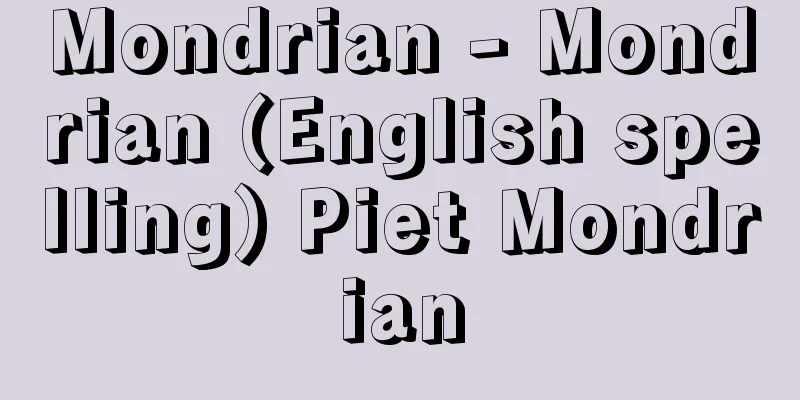Mondrian - Mondrian (English spelling) Piet Mondrian

|
Dutch painter. His real name was Pieter Cornelis M. He was one of the founders of abstract painting and a leading proponent of Neoplasticism. He was born in Amersfoort on March 7th. In 1892, he entered the School of Art in Amsterdam, where he was spiritually influenced by his devout Calvinist father. He was initially influenced by Impressionism, and later by the colors of Matisse, but in 1911, he resonated with Cubism in Paris and began his series of "Trees". During World War I in his homeland, he deepened his exploration of abstraction through this series, and in 1915 he achieved a composition using two horizontal and vertical lines. His plastic theory aims to banish all reproducible elements from painting by combining these two lines, which do not betray the visual sense, with the three primary colors and achromatic colors, and to make order and balance, which suggest the source of vitality, the principles of composition. In 1917, based on this theory (Neoplasticism), he started the De Stijl movement with Doesburg and others. His simple and clear principles influenced not only the development of abstract painting, but also the fields of architecture and design. He returned to Paris in 1919, and published his theoretical work Neoplasticism the following year. Composition in Red, Yellow, and Blue (1921, Gemeentemuseum The Hague) is a representative work of this period. In the 1930s he further simplified the picture plane, producing Composition with Two Lines (1931, Rijksmuseum Amsterdam). He went into exile in London in 1938, and in 1940 in New York. There he produced Broadway Boogie Woogie (1942-43, Museum of Modern Art, New York), a rhythmic work in which colored fields are finely segmented instead of the traditional black lines. He died in New York on February 1, 1944. [Taro Nomura] "Mondrian" commentary by H.L.C. Jaffe, translated by Inui Yoshiaki (1971, Bijutsu Shuppansha) [References] | |Source: Shogakukan Encyclopedia Nipponica About Encyclopedia Nipponica Information | Legend |
|
オランダの画家。本名Pieter Cornelis M.。抽象絵画の創始者の一人で、新造形主義の主唱者。3月7日アメルスフォールトに生まれる。1892年アムステルダムの美術学校に入学し、かたわら敬虔(けいけん)なカルビニストの父親から精神的感化を受ける。初め印象主義、のちマチスの色彩に影響を受けたが、1911年パリでキュビスムに共鳴し、「樹(き)」の連作を始める。第一次世界大戦中故国でこの連作から抽象への探究を深め、15年水平、垂直の二線分による画面構成に達した。視覚を裏切らないこの二線分と、三原色および無彩色の配合とによって絵画からいっさいの再現的要素を追放し、生命力の根源を暗示する秩序と均衡を構成原理にしようとするのがその造形理論である。17年この理論(新造形主義)をもとにドースブルフらとデ・ステイルの運動をおこす。その単純明快な原理は抽象画の進展のみならず、建築、デザインの分野にも影響力をもった。19年パリに戻り、翌年理論書『新造形主義』を出版した。『赤、黄、青のコンポジション』(1921、デン・ハーグ市立美術館)はこの時代の代表作である。30年代にはさらに画面を単純化した『二つの線のコンポジション』(1931・アムステルダム国立美術館)を描く。38年ロンドン、40年ニューヨークに亡命。ここで従来の黒い線にかえて色面を細かく分節化したリズミカルな作品『ブロードウェー・ブギ・ウギ』(1942~43・ニューヨーク近代美術館)を描いた。44年2月1日ニューヨークで没。 [野村太郎] 『H・L・C・ヤッフェ解説、乾由明訳『モンドリアン』(1971・美術出版社)』 [参照項目] | |出典 小学館 日本大百科全書(ニッポニカ)日本大百科全書(ニッポニカ)について 情報 | 凡例 |
<<: Montreal - Montreal (English spelling)
Recommend
Architectural decoration
Decoration added to architecture. It is unclear wh...
Cum
〘Pronoun〙 Opposite. You. ※Nihonbashi (1914)〈Izumi ...
Ivanovo (English spelling)
Ivanovo-Voznesensk until 1932. Capital of Ivanovo ...
Before loading - before loading
During the Heian period, this was a ceremony to o...
School Ordinance - Gakkourei
It is a general term for the Imperial University ...
Candish, T.
…English navigator. Also called Candish. In 1585,...
Hole - Ana
1. A space that penetrates to the other side. &quo...
Old style Kokeshi - Kyuugata Kokeshi
…Originally they were toys for young girls, but f...
Lily Laskine
A French female harpist born in Paris. After grad...
Private collection - Butachu
It is a modern term, but it refers to an individu...
Rain gutter - Ukou
Small ditches formed by the action of rain on bar...
Novelli, Ermete
Born: May 5, 1851. Luke [Died] January 29, 1919. N...
Bretonneau, P.
…It is not clear when the first tracheotomy was p...
Konzanshu
A collection of haiku poems. Edited by Kaede Reito...
POLAMAZONIA
…In addition to this transverse road, other roads...




![Mindanao [island] - Mindanao](/upload/images/67ccf95d1a80e.webp)




